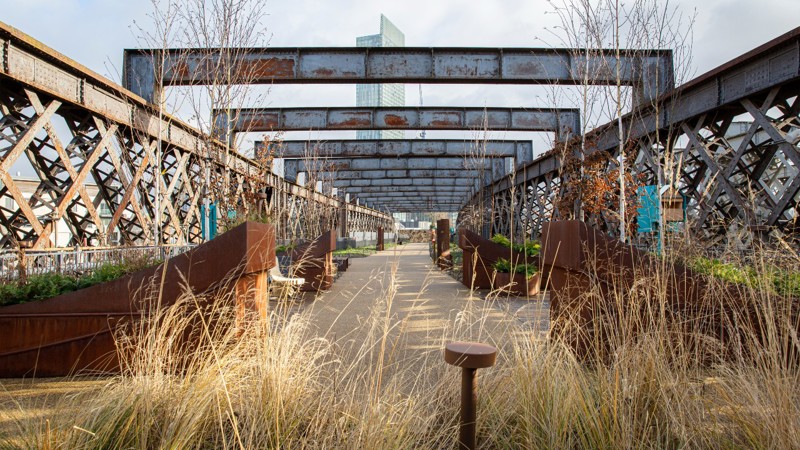Castlefield Viaduct — the ‘garden in the sky’
Transforming Manchester's Castlefield Viaduct from a disused railway structure to a green sky park is a story with many twists and turns, including starring roles on the big screen, says engineer Fiona Smith.

Share this article
Published
02 Aug 2023I've looked after the viaduct in one form or another for 17 years, from engineer for the north to most recently senior engineer for the Historical Railway Estate.
As a structure Castlefield is something of a celebrity in the railway structure world and I remember my first site visit. One of our contractors was telling me how his work on the viaduct’s drainage had been stopped by someone from the film industry who wanted to say hello. He later realised it was Guy Ritchie. Now the site is well known for its role in British TV and film.
I never expected as a civil engineer to be helping a TV crew shoot Peaky Blinders. That’s what makes the viaduct and its Castlefield neighbourhood so special. It’s the oldest part of Manchester, home to Roman ruins, the oldest of the Industrial Revolution canals and the first passenger railway in the world. It was designed by the same person who worked on Blackpool tower, which when opened was the tallest manmade structure in the British Empire.
But with the closure of Manchester Central railway station which the viaduct’s railway lines served in 1969, many asked what would become of the empty structure. From a car park to office space, the ideas came thick and fast but never seemed to lead to anything. So I was taken aback when I picked up the phone to Duncan Laird, Head of Urban at National Trust. He had an idea: a high-rise garden to hover over central Manchester. I was intrigued.
The project takes shape
Looking back, the first Teams meeting we had was surreal; I was stuck in a cold car on my driveway (too long a story to explain). I can only imagine what Duncan and his colleague Sophie Bourne thought about me, but it went well. I could tell both Duncan and Sophie really believed in this idea and had the complete backing of National Trust in making it happen. I was excited about their vision for the viaduct too - even as an engineer, which says something.
What followed next was complicated. We look after the structure on behalf of the Secretary of State for Transport, and National Trust’s idea fell outside of our remit. Many more meetings later, a licence agreement was drawn up with a plan for something to be developed on a temporary basis, to see if there was enough demand for something more permanent. National Trust also needed to secure over £1 million for the project, which came via People’s Postcode Lottery and public donations.
They were keen to include the local community in their plans, drawing on ideas and information from lead community partner Castlefield Forum. So, it was a real collaborative effort from the very beginning: no one organisation could deliver something as ambitious as this project.
A collaborative effort
Our role focuses on safety for our management of the estate. We look after over 3,000 structures across the nation and it’s something we’re passionate about as an organisation. Working with a team of architects, we helped National Trust engineers develop a plan that would make the structure first and foremost safe for use by the public.
Built in 1892, the viaduct’s iron structure has more than enough strength to support the visitor centre and the hundreds of daily visitors walking over the top of it. But the deck that previously carried the railway tracks wasn’t designed to entertain so much weight. Our designers had to think about how they would spread the load and make sure anything heavy was supported adequately across its metal beams.
Luckily, we know this structure well, checking the viaduct every year for maintenance reasons. And once every six years we get up close and personal, within touching distance of every part. This involves our team of engineers abseiling down the side of the viaduct with specialist equipment, managing the added complication of working over an operational railway.
Not all areas of the viaduct needed strengthening, but all the work we did needed to have listed building consent, given the structure’s historical significance.
Opening to the public
No one knew whether the transformation and concept would be appealing to the public – there was no way of knowing who would visit and how people would come until the project was completed and open.
July came and with it visitors, connecting with nature and enjoying the views from the deck. We still had to complete our routine inspections and maintenance while we were open to the public, which was a challenge. One of the ongoing things we’ve needed to manage has been the pigeon population; they love to roost on the viaduct’s girders. They’re not popular with some of the car owners or boat owners who live below the viaduct – I’m sure you can work out why. We know our structures make perfect homes for all kinds of animals, and bats have been known to roost here too. We always aim to improve habitats where we can, working closely with our ecologists to do this.
Although complicated, it’s totally worth the hard work, knowing that the ‘garden in the sky’ has been so well received. Nearly 50,000 people have visited now, with many more to come since the project was extended. National Trust is keen to take forward new ideas for the remaining sections of the garden and I’m very interested to see it evolve further.
I've really enjoyed being involved in something which has had such a positive impact to people’s wellbeing and sense of pride for Manchester.
Image ©National Trust Images Annapurna Mellor
